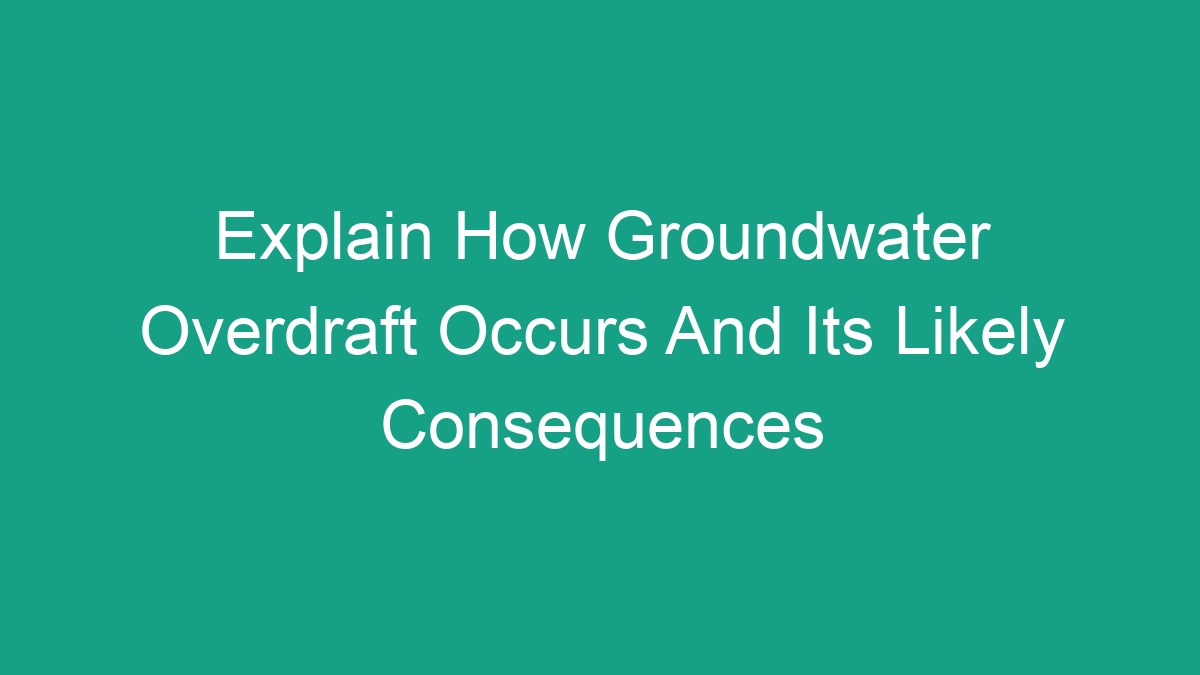
Introduction
Groundwater is a vital resource for human activities, including agriculture, industrial processes, and domestic use. However, over the years, excessive withdrawal of groundwater has led to a phenomenon known as groundwater overdraft. In simple terms, groundwater overdraft occurs when the amount of water extracted from an aquifer exceeds the rate of natural replenishment. This can have significant and long-lasting consequences for the environment, ecosystems, and human communities that rely on groundwater. In this article, we will explore the causes and consequences of groundwater overdraft, as well as potential solutions to mitigate its impact.
Causes of Groundwater Overdraft
1. Excessive Pumping: One of the primary causes of groundwater overdraft is the excessive pumping of groundwater from an aquifer. This often occurs in regions where there is high demand for water, such as in agricultural areas or rapidly growing urban centers. Without adequate regulations and monitoring, the rate of extraction can outpace the natural recharge rate of the aquifer, leading to overdraft.
2. Lack of Regulation: In some cases, the lack of comprehensive regulation and management of groundwater resources can contribute to overdraft. Without clear guidelines on sustainable extraction practices, multiple users may compete for the same water source, leading to over-extraction and depletion of the aquifer.
3. Climate Change: Changes in precipitation patterns and rising temperatures associated with climate change can also exacerbate groundwater overdraft. Reduced rainfall and increased evaporation rates can decrease the amount of water that seeps into the aquifer, further straining groundwater resources.
Likely Consequences of Groundwater Overdraft
1. Depletion of Aquifers: The most immediate consequence of groundwater overdraft is the depletion of aquifers. Once an aquifer is overdrawn, it may take decades or even centuries to naturally replenish, leading to long-term water scarcity.
2. Land Subsidence: As groundwater is extracted from an aquifer, the soil that was previously saturated with water can compact and sink, leading to land subsidence. This can have serious implications for infrastructure, including damage to roads, buildings, and other structures.
3. Saltwater Intrusion: In coastal areas, over-extraction of groundwater can lead to saltwater intrusion, where seawater infiltrates the aquifer. This can render the groundwater unusable for human consumption and agricultural purposes.
4. Ecosystem Impacts: Groundwater overdraft can also have detrimental effects on ecosystems and natural habitats that depend on groundwater for survival. Reduced groundwater levels can lead to the drying up of wetlands, springs, and streams, impacting the plants and animals that rely on these habitats.
5. Quality of Water: Overdraft can lead to the degradation of water quality in aquifers as the concentration of pollutants and naturally occurring contaminants increases due to the reduced volume of water.
Potential Solutions to Groundwater Overdraft
1. Sustainable Management: Implementing sustainable groundwater management practices is essential to addressing overdraft. This includes setting extraction limits, monitoring aquifer levels, and promoting water conservation.
2. Recharge Projects: Artificial recharge projects, such as spreading basins, injection wells, and recharge ponds, can help replenish aquifers by allowing surface water to percolate into the groundwater system.
3. Desalination: In regions facing saltwater intrusion, desalination technologies can be employed to treat saline groundwater, making it suitable for various uses.
4. Diversification of Water Sources: Diversifying water sources through the use of rainwater harvesting, stormwater capture, and treated wastewater can help reduce reliance on groundwater and alleviate overdraft.
Conclusion
In conclusion, groundwater overdraft is a critical issue that can have far-reaching consequences for natural ecosystems and human societies. It is imperative that effective measures are taken to address the causes of overdraft and mitigate its impact. Through sustainable management practices, artificial recharge projects, and diversification of water sources, we can work towards ensuring the long-term viability of groundwater resources for future generations. It is essential that policymakers, water resource managers, and communities collaborate to implement solutions that will preserve and protect this invaluable natural resource.



